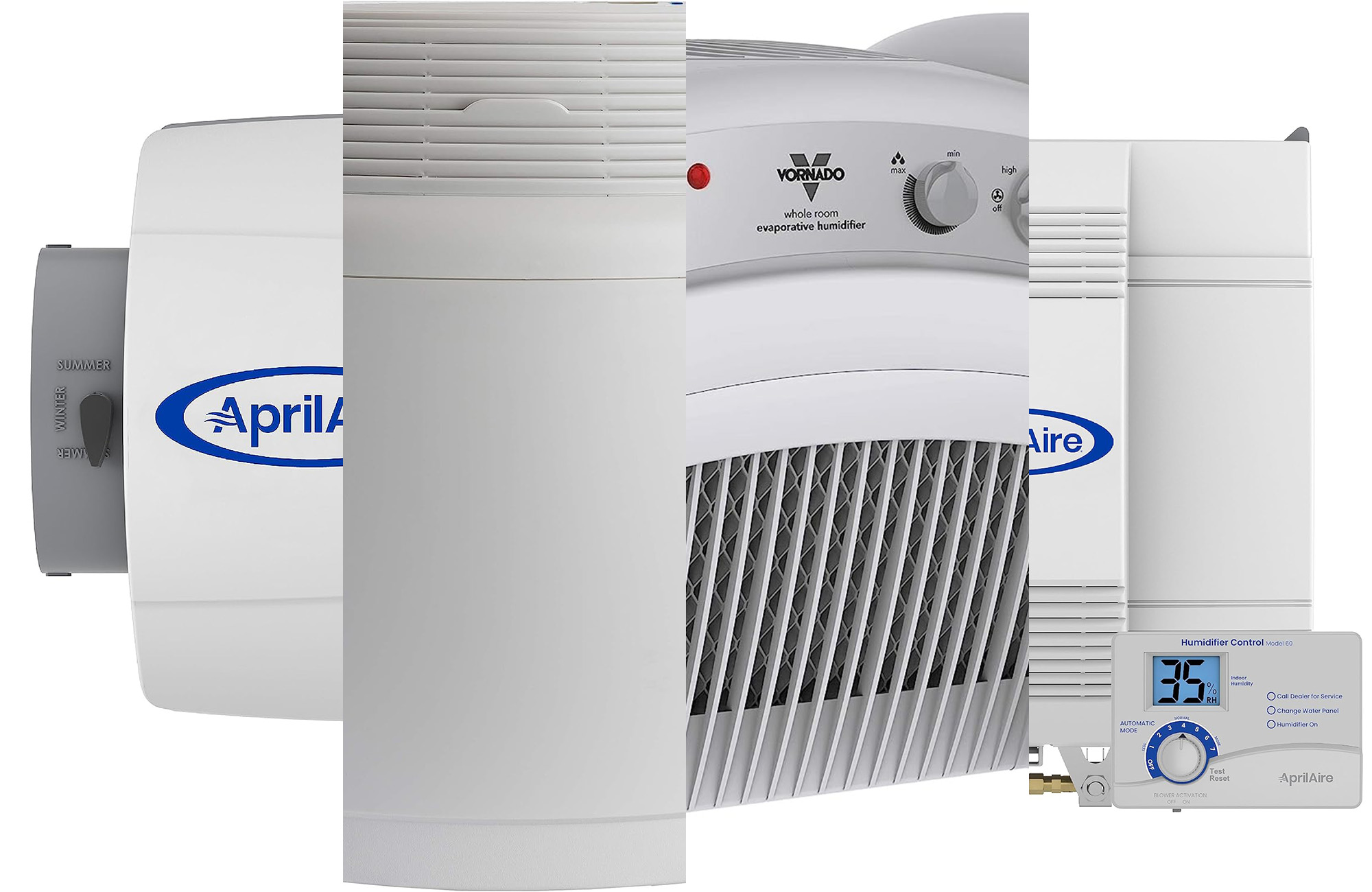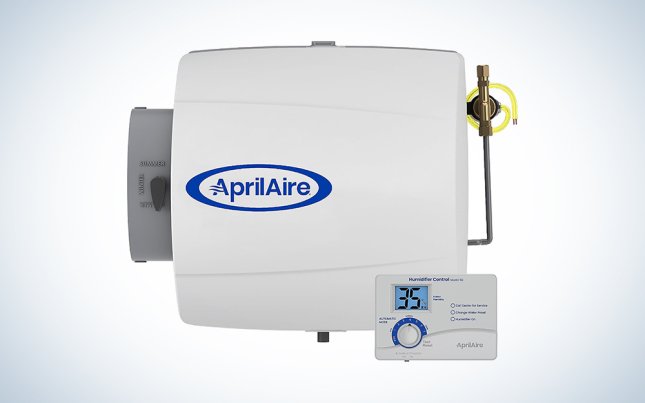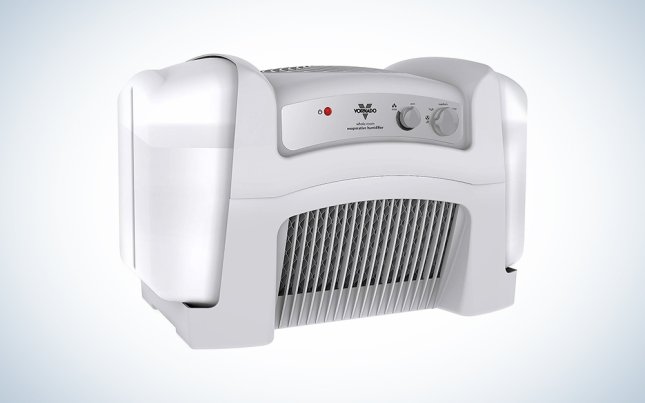We may earn revenue from the products available on this page and participate in affiliate programs. Learn more ›

Low humidity may not seem bad—given that high humidity inside can damage wallpaper, painted surfaces, and even tiling throughout your home—so you might not have given whole-house humidifiers much thought. However, low humidity can cause just as many unpleasant effects, including dry skin, dry eyes, itchy throat, nosebleeds, dehydration, and cold symptoms. It can also exasperate allergies and respiratory problems, like asthma. With this in mind, if the home is prone to low humidity during the peak of summer or winter, installing a whole-house humidifier is a good idea. A whole-house humidifier is an appliance that is designed to add moisture to the air. These devices typically have a built-in fan or connect to the home HVAC system to pump moisture-heavy air into the home. Learn more about these appliances with this informative guide to find the best whole-house humidifiers for your home.
- Best overall: AprilAire 500 Whole House Humidifier
- Best value: AIRCARE Space Saver Evaporative Humidifier
- Best portable: Vornado Evap40 Humidifier
- Best for large homes: AprilAire 700 Whole House Humidifier
- Best for small homes: LACIDOLL Whole House Humidifier
How we chose the best whole-house humidifiers
Before choosing the top whole-house humidifiers for this list, it was necessary to put together a broad pool of options. This wide range of products was narrowed down through extensive research to select the best options. We treat getting the moisture into your air just as seriously as we do taking it out of your basement. The most important factors when deciding on the best appliances for this list include the unit’s capacity, the intended coverage area, the type of humidifier, and the maximum runtime.
Capacity refers to the amount of water the unit can hold in the water storage tank, though it can also mean the maximum water use over 24 hours for HVAC-compatible models. A higher capacity typically indicates a higher runtime and a broader coverage area. However, the runtime of each humidifier can be affected by the size of the home, so it was important to have models suitable for both small and large homes. With this in mind, the list of the best whole-house humidifiers includes several top options ranging in runtime, capacity, and coverage area.
The best whole-house humidifiers: Reviews & Recommendations
This list was compiled after researching a wide pool of potential products and comparing important product factors, including humidifier type, coverage area, tank capacity, and runtime. Consider the top options on this list to find the best whole-house humidifiers to treat dry air at home and its effects on your body.
Best overall: AprilAire 500 Whole-House Humidifier
Best overall
AprilAire 500 Whole House Humidifier
Pros
- Easy-to-read control panel
- Dual monitoring sensors
- High daily output capacity
- Compact design
Cons
- Unit is not portable and may require professional installation
Why it made the cut: Connect this whole-home humidifier to the HVAC system for optimum humidity throughout the home.
Specs
- Type: HVAC Compatible
- Coverage Area: 3,600 Sq. Ft.
- Tank Capacity: 12 gallons per day
- Runtime: Continuous
When the house is prone to low humidity, a whole-house humidifier, like this product by AprilAire, is a great solution to the problem. The humidifier is relatively compact and compatible with home HVAC systems, so it can be installed without taking up too much space or sticking out. The main body of the humidifier has a slim, square profile with an off-white color that blends in with other common household appliances.
This unit comes with an easy-to-use electronic control that allows the users to set the desired indoor humidity level, control the fan, and check the settings on the bold digital screen. Some DIYers may have the experience and knowledge necessary to install this whole-home humidifier, though the manufacturer recommends professional installation to ensure that there are no problems.
Additionally, the whole-home humidifier is suitable for spaces of up to 3,600 square feet and can use up to 12 gallons of water per day. The unit continues to run as long as the ambient humidity in the home is still below the set level. This appliance also has dual built-in monitoring sensors that allow it to monitor and respond to both outdoor temperatures and indoor relative humidity. However, this whole-home humidifier is not a good choice for anyone looking for a portable unit.
Best value: AIRCARE Space Saver Evaporative Humidifier
Best value
AIRCARE Space Saver Evaporative Humidifier
Pros
- Digital controls and refill indicators
- Up to 70 hours of run time on six gallons of water
- Portable design can be moved around the home
- Three fan speeds and customizable humidity settings
Cons
- Not intended for large homes
Why it made the cut: Increase the humidity in the home with this evaporative humidifier suitable for spaces up to 2,700 square feet.
Specs
- Type: Console
- Coverage Area: 2,700 Sq. Ft.
- Tank Capacity: 6 gallons
- Runtime: Up to 70 hours
Humidity issues can occur in any room of the house, so it’s important to select a whole-house humidifier suited for the home’s size. HVAC-compatible models connect to the HVAC system and use the existing ductwork to distribute moisture-heavy air throughout the home. This console whole-home humidifier can’t connect to the ductwork, but it can be moved to different locations around the home where it’s needed most.
The humidifier has easy-to-use digital controls and features a refill indicator so that homeowners know when to top up the water tank. The humidifier can operate for up to 70 hours with a full six-gallon water tank. Users can set the desired humidity level and adjust the fan speed between low, medium, and high for optimal output. However, this evaporative humidifier is not recommended for larger homes that exceed the 2,700-square-foot coverage area.
Best portable: Vornado Evap40 Humidifier
Best portable
Vornado Evap40 Humidifier
Pros
- Simple dial controls for humidity and fan speed
- Three fan speeds from 750 to 1,600 RPM
- Short, broad body can’t be easily knocked over
- Two water storage tanks
Cons
- Low water storage capacity
Why it made the cut: Take advantage of the portable design to set up the Vornado whole-house humidifier in any room of the home.
Specs
- Type: Console
- Coverage Area: 1,000 Sq. Ft.
- Tank Capacity: 4 gallons
- Runtime: Up to 24 hours
One of the main problems with tall, narrow console humidifiers is that they can be knocked over relatively easily. When this occurs, the water in the storage tank can spill out onto the floor, creating a big mess to clean up. This Vornado Evap40 Humidifier doesn’t have this problem due to the short, broad body that sits low on the floor. It also features two water storage tanks, which are mounted on either side of the appliance to balance the design.
The console whole-house humidifier is suitable for apartments and condos that measure about 1,000 square feet. It can be set up and controlled with the simple dials on the front of the unit. One dial controls the fan speed setting, which ranges from 750 RPM to 1,600 RPM, while the other dial controls the humidity setting. Just keep in mind that the four-gallon storage capacity may be too small for use in larger areas.
Best for large homes: AprilAire 700 Whole-House Humidifier
Best for large homes
AprilAire 700 Whole House Humidifier
Pros
- Compact size doesn’t take up a lot of space
- Broad coverage area is ideal for larger homes
- Dual sensors monitor outdoor temperature and ambient humidity
- Built-in fan increases airflow through the humidifier
Cons
- Requires professional installation
- High cost
Why it made the cut: Install this HVAC-compatible whole-house humidifier for larger homes, with continuous runtime and a capacity of up to 18 gallons of water per day.
Specs
- Type: HVAC Compatible
- Coverage Area: 5,300 Sq. Ft.
- Tank Capacity: 18 gallons per day
- Runtime: Continuous
A problem with purchasing whole-house humidifiers for larger homes is that many models do not have the required output capacity or coverage area to improve the humidity levels throughout the entire home effectively. However, this HVAC-compatible whole-home humidifier by AprilAire has a wide coverage area of up to 5,300 square feet. This appliance can also use up to 18 gallons of water per day to increase the relative humidity in the house.
Since this appliance connects directly to the HVAC system, it can keep running continuously without worrying about refilling a storage tank. This model has dual monitoring sensors that are used to keep track of the outdoor temperature, as well as the relative humidity in the home. Additionally, the humidifier has a built-in fan that pulls heated air from the furnace through the humidifier to improve the airflow. Though, it’s necessary to note that this unit will require professional installation, which can increase the already high cost of this product.
Best for small homes: LACIDOLL Whole House Humidifier
Best for small homes
LACIDOLL Whole House Humidifier
Pros
- Wheeled for easy mobility
- Dual 360-degree output nozzles
- Adjustable mist settings and remote control functionality
- Top fill design and removable water storage tank
Cons
- Not intended for home larger than 2,000 square feet
Why it made the cut: Set up this console whole-house humidifier in a central location and use the dual 360-degree nozzles to distribute a fine mist throughout the air.
Specs
- Type: Console
- Coverage Area: 2,000 Sq. Ft.
- Tank Capacity: 5.5 gallons
- Runtime: Up to 48 hours
Small homes don’t require oversized humidifiers to eliminate arid conditions within the home. Instead, this console whole-house humidifier is an ideal option for homes up to 2,000 square feet in size. The humidifier has a 5.5-gallon water storage tank that can be removed for easy cleaning. However, the tank does not need to be taken out to fill the humidifier. Just pour the water into the appliance using the top fill function.
Users can set the mist diffusion level and adjust the fan speed with the touch panel on the front of the humidifier or with the included remote control. This appliance comes with wheels to improve the portability of the unit and also includes dual 360-degree misting nozzles that can be adjusted for the ideal output. The humidifier can run for up to 48 hours on a full water tank, though this model is not designed for larger homes.
Things to consider when buying a whole-house humidifier
Before investing in a whole-house humidifier to balance the humidity levels throughout the home, it’s a good idea to research these products to learn more about the factors that can affect the appliance’s operation. Consider the type, runtime, coverage area, and capacity when shopping for the best whole-house humidifiers for your home.
Type
Whole-house humidifiers typically fall into one of two distinct types, including models that are compatible with existing HVAC systems and freestanding console humidifiers.
- HVAC-compatible whole-home humidifiers are designed to connect to the existing HVAC system for continuous use and unlimited runtime. This type of humidifier can include a small device that adds steam to the HVAC system to moisten dry, warm air. However, it’s important to note that these appliances still have a maximum capacity that measures the amount of water they can use in a 24-hour period. The coverage area also limits HVAC-compatible models, so make sure to invest in a unit that is suitable for the size of the home.
- Console whole-home humidifiers can be moved around the home to better distribute the moisture into the areas that are most in need. These appliances have a drawer or similar compartment to store the water that the humidifier will need throughout the day. Runtime for these humidifiers depends on the capacity of the tank and the intended coverage area.
Runtime
Another factor to consider when investing in a new whole-house humidifier is the device’s runtime. Whole-home humidifiers that are compatible with the HVAC system don’t generally have a limited runtime, so they can run continuously as needed. However, console whole-home humidifiers typically have a runtime that is limited by the amount of water in the unit.
Additionally, the runtime can be affected by the size of the area and how effectively the home is sealed. If you are trying to use a humidifier with a small 1,000 square foot coverage to increase the humidity in a home that is three times the size, then the unit will run dry much faster than if it was used in an appropriate space. Similarly, if there are gaps and cracks around the home’s exterior that allow dry air to seep in from outside, then the humidifier will need to work harder to keep up with demand, leading to a shorter runtime.
Coverage area
The coverage area of the whole-house humidifier refers to the maximum space that the appliance is designed to humidify. This doesn’t mean that the humidifier cannot be used in a larger or smaller home than the coverage area, but the runtime and efficiency of the unit may be affected by this decision. For instance, using a humidifier with a coverage area of 1,200 square feet for a space of 2,400 square feet can help increase the humidity, but the humidifier will run dry faster than expected as the appliance works to keep up with demand.
Units that are too large for the space will simply shut off when the air reaches the intended humidity level, though these appliances can take up more room than necessary for the smaller area. Consider the size of the home and look for a whole-home humidifier with a similar coverage area.
Capacity
Whole-house humidifiers that attach directly to the HVAC system can function continuously, so users don’t need to worry about runtime or refilling a water storage tank. However, these appliances still have a maximum amount of water they can use over 24 hours.
Console whole-home humidifiers have a built-in tank to store the water that will be used to increase the humidity in the home. The capacity of the unit is equal to the size of the water storage tank. Some units may have more than one storage tank or a method to fill the appliance while it is in use. These features are ideal for extending the runtime of the humidifier and making up for smaller storage tank capacity.
FAQs
A professional or an experienced DIYer could install an HVAC-compatible whole-home humidifier in about two hours. Installing a console whole-home humidifier takes just a few minutes to position it, plug it in, and fill the water storage tank.
The best location to set up a whole-home humidifier is in the most central room of the home, which is usually a living room or dining room area. In the middle of the home, the humidifier’s output can evenly affect the greatest area.
The amount of water that a whole-home humidifier uses depends on the model. Some small units may only use one or two gallons of water to humidify a small condo or apartment. Larger units may use over 12 gallons a day to increase the humidity to the intended level.
Final thoughts on the best whole-house humidifiers
- Best overall: AprilAire 500 Whole House Humidifier
- Best value: AIRCARE Space Saver Evaporative Humidifier
- Best portable: Vornado Evap40 Humidifier
- Best for large homes: AprilAire 700 Whole House Humidifier
- Best for small homes: LACIDOLL Whole House Humidifier
Low humidity conditions can have a substantial impact on personal health and the health of anyone living in the home. Extended periods of low humidity can exacerbate existing allergies and respiratory conditions, like asthma, so it’s important to take action to address low humidity problems in the home. Dry air is common during the peak of the summer and the middle of the winter.
Prepare for low humidity by investing in a whole-house humidifier for the house. An HVAC-compatible model is the best choice for even distribution and coverage in larger homes, while a console whole-house humidifier is ideal for small to medium homes. Console humidifiers are also a good option if you want to move the unit around the home because they are typically designed for portability. Consider the needs of the household to find the best whole-house humidifiers to treat low humidity conditions.








